Mysteries and secrets from the ancient Middle Eastern civilizations that we could not understand until today: From Sumer was the beginning
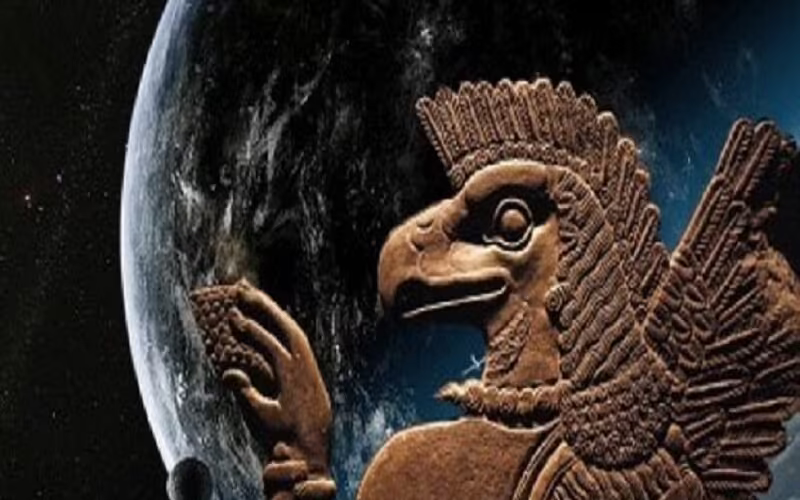
What is the mystery of the group of planets surrounding the sun, which was drawn by the Sumerians 3500 BC! Did they know since that time the centrality of the sun and the number of planets in the solar system! And what is the secret of the great similarity between many heavenly religious texts with Babylonian myths! And what is the truth of those hanging gardens, where did they disappear!
The civilizations of the ancient Middle East are wonders in their own right. Those cities and the monuments they built, the stories and legends they wrote, the inventions, sciences and technologies they created, the wonders that continue to amaze the world. Among all that, we will talk about some issues related to those civilizations that are still obscure or incomprehensible to us. Perhaps we can describe it with mysteries and secrets that we have not been able to understand until today.
Coming from space
Today , in the twenty-first century, after 6000 years of existence, we must be using one of their inventions every day, to ask you about time, to use wheeled vehicles, or to listen to what your horoscope says today! They are the Sumerians. The Sumerian civilization was a superior and advanced civilization, which in itself is a puzzle that we have not been able to understand until today. Why! Because everything began with them, and even “history begins from Sumer.”
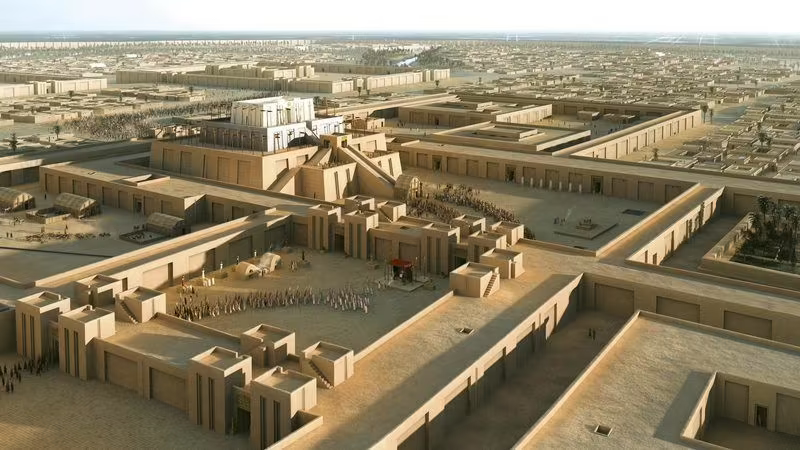
A hypothetical image of a Sumerian city
Sumer is an ancient civilization founded in Mesopotamia, in the southern region between the Tigris and Euphrates rivers, what is known today as Iraq. These people settled this area about 4500 or 4000 years ago, and their control over the area lasted about 2000 years, until the Babylonians took over after them.

The green dot shows where the Sumerian civilization originated
The mystery of the solar system inscriptions at the Sumerians and the issue of the planet Nibiru
Before the nineteenth century, no one had heard of the Sumerian civilization, as if it had never been born. However, everything changed in 1850 AD, when the English explorer and Assyriologist Austin Henry Layard stumbled upon the library of King Ashurbanipal while searching for Babylonian and Assyrian antiquities, in the ruins of the city of Nineveh in northern Iraq. The library consists of 30,000 clay tablets and written remains of the Akkadian and Sumerian languages.

Sumerian tablets found in the library of Ashurbanipal
The Sumerian civilization woke up from its long slumber, and revealed its wonders. Some of these tablets have raised eyebrows, especially the cylinder seal named VA 243 after the number it bears in the Vorderasiatische Museum in Germany. Dear reader, look at the
? inscription in the upper left corner of this seal, what do you see
Doesn't this inscription resemble a drawing of the sun surrounded by
! eleven bodies

Sumerian cylinder seal with the name Va243
Of course, we are aware today that there are eight planets in the solar system , and nine with Pluto - the dwarf planet - and with the presence of the sun and the moon (the ancient peoples, including the Sumerians, considered the sun and the moon to be planets), the missing puzzle is the twelfth planet, the planet Nipro, which We will return to it below. Returning to the inscription, is it possible that the Sumerians were aware of the number of planets in the solar system
? and heliocentrism by 4000 BC

Seal Va 243
Zechariah Sitchin, who identifies himself on his official website as “one of the few scholars able to read and interpret ancient Sumerian and Akkadian clay tablets,” assumes that the Sumerians possessed very advanced astronomical knowledge, and that this knowledge was given to them by their gods, the Anunnaki gods. , who came to Earth half a million years ago.
According to his translation of the Sumerian tablets, these creatures, which are twice the length of normal humans, came from the planet Nibiru, and landed in Africa to search for the gold needed for their planet, but the difficulty of mining prompted them to create exploitable working human beings, by genetic modification of the
! original earthlings, Or what they called ancestors
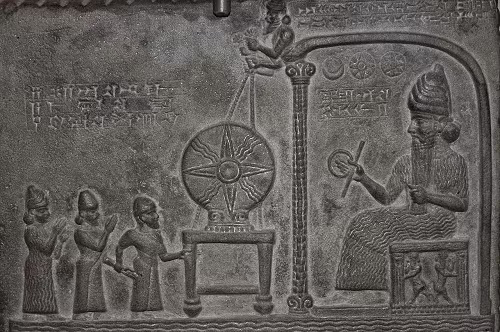
Seal illustrating one of the Anunnaki deities
"I didn't make it up ," Sechin told the New York Times in 2010, shortly before his death. They wanted to create primitive workers from Homo erectus, and give him the genes needed to allow him to think and use tools.” Of course, the seal (Va 243) is the cornerstone of Sitchin's theory.
What is the truth behind the inscriptions of the solar system when the Sumerians
Sichin's story may seem a little ridiculous, but it is widely spread, reported by many foreign and Arab websites, YouTube channels, Facebook pages, and others. Dear reader, you can watch the following clip on the History Channel to be sure of the extent of this hypothesis.

At the outset, we must mention that the study of cylinder seals is a very specialized sub-study in Sumerology and Assyriology. Michael Heyers, a specialist in the study of ancient Semitic languages , says in a paper published at the University of Wisconsin, USA, that through the efforts of specialists in cylinder seals, Sechin's interpretation of the inscription is wrong and lacks scientific merit.
The purported sun symbol on the inscription is inconsistent with the consistent depiction of the sun in hundreds of other cylinder seals and Sumerian artwork, which is known as a result of its frequent appearance alongside texts relating to the Sumerian sun god Utu. The symbol of the sun god in the Sumerian religion was drawn in the form of a central circle with four arms with wavy lines between each arms, and most of the time the whole symbol was surrounded by an outer circle.
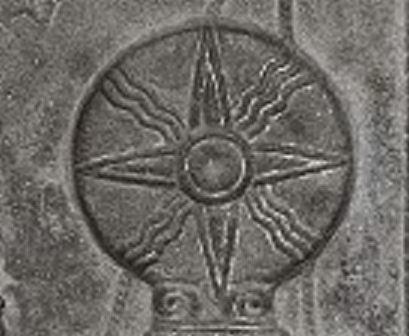
The typical form of the sun symbol for the Sumerians
The researcher says that the symbol on the inscription is a symbol of a star, as the Sumerians often painted the star with eight or six arms. Although we now know that the sun is also a star, but not among the Sumerians, they separated the sun, the moon, and the star from each other in their works.
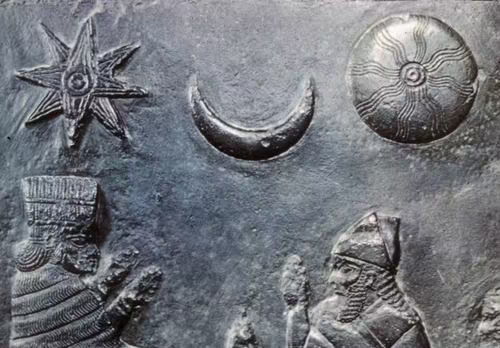
The difference between the symbol of the sun, moon and star among the Sumerians
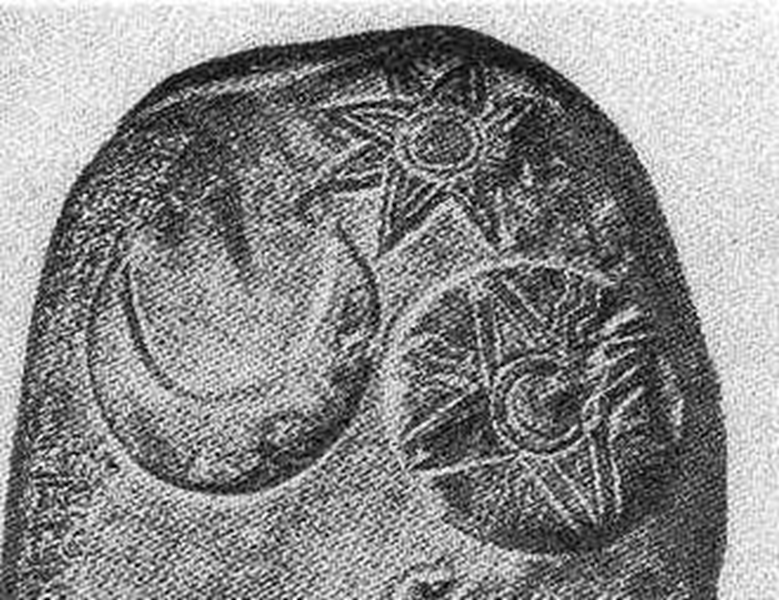
Another work that clarifies the difference between the sun, moon and star among the Sumerians
However , if that “sun” in the inscription does not refer to the sun, then what are those points around it? According to Michael Heyers' interpretation, this central six-ray star with the surrounding stars is a stellar constellation, and most likely refers to the Pleiades Cluster.
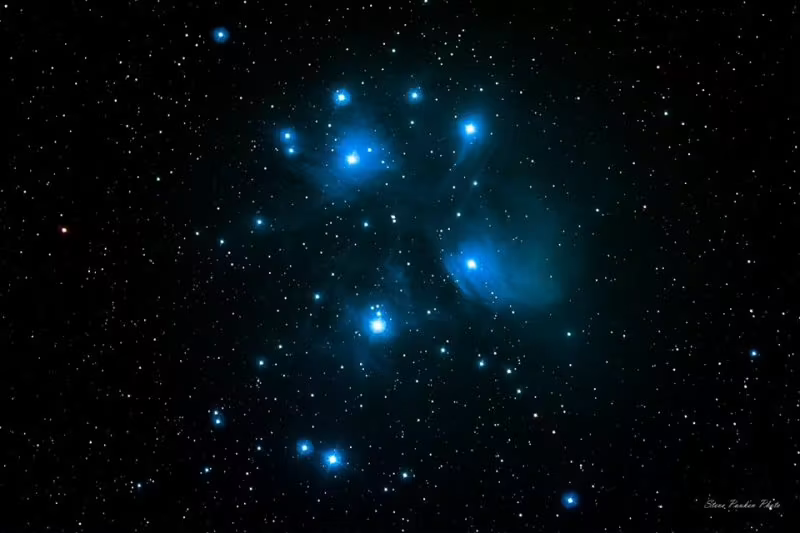
chandeliers cluster
The Pleiades are the most famous and brightest open star cluster, located about 410 light-years from Earth, in the constellation of Taurus. Various ancient civilizations called them "the seven sisters", or "the seven virgins", the seven little girls . This may seem strange to modern observers, as they can usually distinguish only six stars in the cluster. This is, of course, the result of the light pollution that our civilization suffers from. But with a clear and dark ancient sky, and sharp eyes watching closely, up to 12 stars can be detected from the Pleiades cluster! Does this number remind you of anything?
Planet Nibiru, is it waiting for us in that cold dark space
According to Sichin's translation of the Sumerian writing, Nibiru is the twelfth planet in the Sumerian group of planets in the solar system. The collision of one of its moons in ancient times with Tiamat, a planet located between Mars and Jupiter, led to the formation of Earth, the asteroid belt and the Moon.
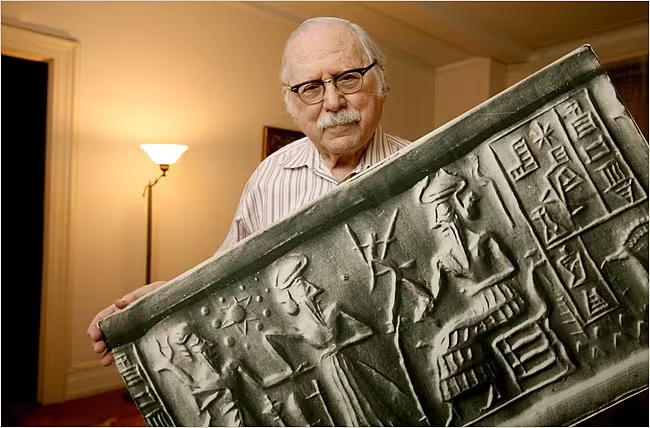
Zacharias Sechin
It must be noted that the term “ Nibiru ” is mentioned in the Sumerian cuneiform tablets and writings , and it means “the transiting planet,” and its cuneiform sign was a cross or a winged disk. Some experts suggest that the term refers to a fixed point in the sky, and after the reconfiguration of the fifth tablet of the " Enuma Eilish " epic, experts translated the name "Nibiru" to "Pole Star". As for the assumption of the existence of the planet Nibiru, which revolves around the sun every 3,600 Earth years, it is a possibility rejected by the scientific communities in the field of archeology and astronomy, and considered it a pseudo and marginal science.
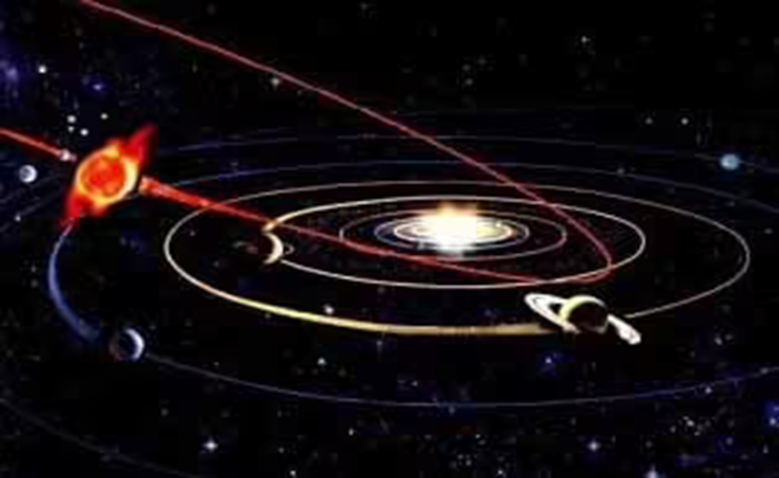
Planet Nibiru and its anomalous orbit
A planet with an orbit so anomalous that it takes 3,600 years to orbit the sun would create instability within the solar system, since after only a few revolutions, its gravity would have caused major disruption to the other planets.
But , despite all of the above, there may actually be an undiscovered planet in the cold, dark depths of the outer solar system. He calls it the ninth planet after Pluto lost its status, and some call it Planet X. Some astronomers have noticed strange gatherings in the orbits of small bodies outside Neptune, and the best explanation for this is the existence of that mysterious planet.
Sumer fact
Admittedly, the Sumerian civilization was an exceptional civilization, and to this day some have not been able to understand the mystery of this civilization, and the reasons for that progress and creative thinking that the Sumerians had, so they thought that aliens and the genetic modification they made were behind that superiority! This theory may be ridiculous, but what the Sumerians did is considered something extraordinary, and until you get the full picture, I will mention some of what that civilization achieved, even if we depart a little from the basic story, I hope you include me in your dream, dear reader.
The historian and expert on Sumerian history and language, Samuel Noah Kramer, wrote, “The Sumerians had an extraordinary penchant for technological invention. They focused spiritually and psychologically on ambition, success, leadership, honor and recognition.”

Noah Samuel Kramer
Kramer also wrote in his work “History Begins from Sumer” 39 articles of human civilization that arose in Sumer, and these lists: the first school, the first case of tax cuts, the first pharmacopoeia, the first historian, the first agricultural calendar, the first epic poem about Gilgamesh , first experience in planting shade trees, first love song, first aquarium, first literary debates, and many more.
The Sumerians invented the sexagesimal counting system, which they used in measuring time and still today, as the origin of the sixty minutes in an hour and sixty seconds in a minute is due to the civilizations of that region. In addition to their extensive knowledge of arithmetic operations and mathematical relationships.
From that time immemorial, the Sumerians were interested in astronomy and astrology. They tracked the movement of the sun and the moon, set the lunar calendar, and were able to predict astronomical events such as eclipses . They also painted the stars in groups, divided the night sky into 12 parts, and called them the names of the constellations, which have come down to us from later Greek and Latin translations.
According to archaeological evidence, the Sumerian civilization established approximately twelve cities by the fourth millennium BC. It is a system called city-states, where each city contains a wall surrounding it, in the middle of which is the “Zagora”, a temple in the form of a tiered pyramid of terraces associated with the Sumerian religion.

ziggurat "Ur"
The principal city-states included Eridu, Nippur, Lagash, Kish, Ur, and the first real city, Uruk. The city of Uruk is a thriving commercial center. In its golden age of 2800 BC, Uruk had a population of between 40,000 and 80,000 people, living within 6 miles of defensive walls, making it probably the largest city in the ancient world.
When human history was a blank page, the Sumerians carved the first word. They developed the world's first writing system, known as cuneiform, around 3400 BC. It is a text consisting of wedge-shaped marks, written using sharp reeds that are pressed into wet clay, then dried, to form clay tablets. Writing was most likely used at the beginning to record accounts and commercial transactions, but it soon developed into a complete writing system used to record history, laws, literature, poetry, etc., and they documented all their records on clay tablets.

Cuneiform writing
They also excelled in hydraulic engineering, discovering how to collect and direct the floods of the Tigris and Euphrates rivers, and designed complex systems of aqueducts and dams whose gates could be opened and closed to regulate the flow of water. They excelled in metallurgy, and used copper to make many useful items, from spearheads to razors, and works of art. They invented the plow, built sailboats, and invented spinning wheels that were used to make pottery in large quantities, and more.
They are the ancestors of modern manufacturing companies. While other cultures in the Middle East collected wool to weave clothes, the Sumerians were the first to do so on an industrial scale, forming large textile workshops.
The mystery of the similar religious texts between the monotheistic religions with the Babylonian and Sumerian myths
Let's go back to the beginning. It is mentioned in the Noble Qur’an in Surat Hud: “And He it is Who created the heavens and the earth in six days, and His Throne was over water,” and also in Surat Al-Anbiya, verse 30, “And We made from water every living thing.” And before the Holy Qur’an, it was written in the Torah: “And the earth was without form and void, and darkness was upon the face of the deep, and the Spirit of the Lord hovered over the face of the waters.”
Before the existence of the Torah, the Egyptians wrote that the god Ra was the first god to emerge from the first waters, and from him the universe and the rest of the gods were created. Before the Egyptians, the Syrian myth was in the genesis, in which the goddess Yam was the first water, over which the god Baal triumphed, and then proceeded to organize the universe. And before the Syrians, the Babylonians wrote, “When in the highest there was no heaven, and below there was no earth.” There was nothing but water. This Babylonian creation myth known as "Enuma Elish" tells that the entire universe was born of the first water deities in general.
And before the Babylonians, but above all, the Sumerians. Creation myths emerged from their ideas. They inscribed on their clay tablets, in their first cuneiform script, the first creation myth. From the Sumerian gods, growth, the first waters, everything sprang up.
This similarity between religious texts and the pagan myths of formation in the civilizations of the ancient East is one of the most baffling issues related to those civilizations, in my opinion. It doesn't just depend on the idea that the universe was born from water, there are plenty of stories that are pretty similar, including:
Separating the sky from the earth
In the Babylonian myth, and the Babylonians, as we mentioned earlier, are the civilization or empire that followed the Sumerians and inhabited Mesopotamia for nearly 2000 years, Marduk, the great Babylonian goddess, divides the body of the goddess Taamah, the first water, into two halves, raising one of them, which is the sky, and simplifies the other, which is the earth.
The Greeks were followed by the Greeks, and in Greek mythology also, they are Gea, the goddess of the earth, who gives birth to Uranus, the god of the sky, which completely surrounds her, and then they are separated from each other and separated by force. Later in the Torah, Jehovah, the God of the Hebrews, separates the first waters into two parts, one of which is raised to form the sky, and the other is spread out, whose water gathers on one side and the land protrudes on one side.
Finally, in the Noble Qur’an, God Almighty says: “Did those who disbelieve not see that the heavens and the earth were joined together, so We separated them?”
the flood
In the Noble Qur’an, in Surah Hud, God Almighty said: “We said: I carry two of each spouse and your family, except for those against whom the word has preceded, and those who believed, and those with whom only a few believed.” And in the Torah: “And the Lord said to Noah, “Go into the ark, you and all your family, for I have seen you righteous before me in this generation.” And the Babylonians have a legend that says: “Destroy your house, build a ship, abandon your possessions, and save yourself. Leave your belongings and save your life. And I bear in it the seed of every living thing.”
The main themes of the flood story are repeated in the heavenly religions and the legends of the civilizations of the East. The outlines of the legend are: a divine order that a huge flood would destroy the earth, with the choice of a righteous person to build a ship and save some creatures, then the water disaster ended and life continued again. But of course, the oldest texts of the flood were mentioned in the Epic of Gilgamesh , a Sumerian literary epic, found in the library of King Ashurbanipal to which we referred earlier.
Falling from Heaven
You all know the story, there is no need to poke the old wound, and the heartbreak for those days. I will just mention a Sumerian legend regarding that happy land, and then compare yourselves.
“The land of Dilmun is a pure place, the land of Dilmun is a clean place
The Land of Dilmun is a clean place, The Land of Dilmun is a bright place.”
The Sumerian legend says that Dilmun is the paradise in which Enki, the god of water, lived with his wife, Ninkhrasaj, the goddess of the earth. Does it take more than good soil irrigated by fresh water to create a green paradise! But happiness does not last. Ninkharsaj grows eight kinds of wondrous trees, and before you reap the fruits and rejoice in them, he says that you pick those fruits and eat them all.
Ninkharsaj gets angry and curses Enki, "Until death comes to you, I won't look at you with the eyes of life." Such a curse means disaster, disaster means scarcity of water. Enki suffers eight ills, suffers, and regrets. Then the gods intervene to resolve the dispute, so Ninkhrsaj agrees to heal Enki, and she creates the appropriate deity for each ailment, until the matter reaches the bug of the rib, because his rib hurts him, so Ninkhsaj creates the goddess Nenti for him.
And “Nanti” is a word of two parts, the part “te” means a rib in the Sumerian language, it also comes with the meaning “make him live” or “live,” and the part “nun” means a lady, so the meaning of the name “Nenti” becomes the woman who revives, or lady rib. Is this story similar to the story of Eve, who was created from Adam’s rib, Eve who “revives”!
Why all this similarity between the heavenly religious texts with the Babylonian and Sumerian myths?
There are three possibilities. The first is the dependence of the Babylonian and Sumerian myths on the texts of the Torah, which is an unlikely possibility, because the epic of Enuma Elish dates back to 1800 BC, that is, approximately four centuries before the birth of the Prophet Moses.
The second possibility is that the Torah was based on the Babylonian legend, which is a reasonable possibility, as the Babylonian language and cuneiform writing had spread throughout the entire region in the middle of the second millennium BC. Circumstances also desired that the Hebrews be acquainted with Babylonian literature during the Babylonian captivity to the Hebrews in the sixth century BC.
The third possibility is that both the Babylonian and the biblical texts were based on older texts, meaning that the two beliefs may have been influenced by an ancient religion that left its mark in later beliefs..
The Mystery of the Hanging Gardens of Babylon
We will not stray far from the Babylonian civilization, as it contains many secrets that are surprising. But we will take you a little further back to Greece, to about 225 B.C., when the Greek engineer Philo wrote a list of seven things, a list that has come to be known today as the Seven Wonders of the Ancient World: the Pyramids of Giza, the Temple of Artemis at Ephesus, the statue of Zeus at Olympia, the mausoleum of Halicarnassus, a lighthouse Alexandria, and most mysterious of all, the Hanging Gardens of Babylon.

Seven Wonders of the Ancient World
Only the Giza pyramids survive , while five of them have disappeared or are in ruins. Despite this, there is sufficient documentary and archaeological evidence that indicates its existence, and that it is not the product of legends and rumors. All but one, the Hanging Gardens of Babylon, are the biggest puzzle on the list.
These gardens are considered the achievement of the great King of Babylon Nebuchadnezzar II, who ruled in the period (605-561) BC. To this day, no evidence has been found indicating any ruins or antiquities that tell us anything about these gardens, and they are not mentioned in any of the Babylonian sources.
The search for this wonder is one of the most moving expeditions to study Mesopotamia. Archaeologists are still confused about where the gardens might have been, what they looked like, what the term “suspended” basically means, and how they were irrigated, in short, whether they even existed or not!
Sumerian civilization
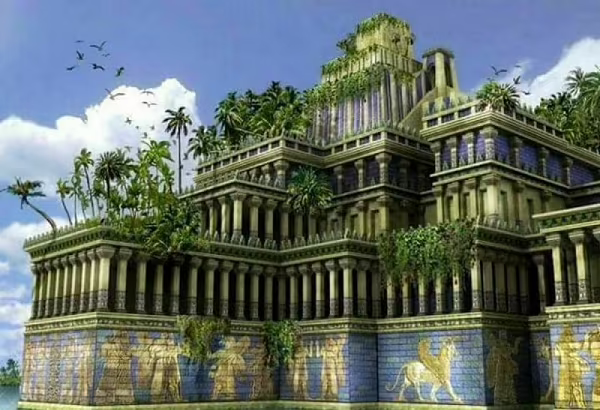
A hypothetical drawing of the Hanging Gardens of Babylon
Philo wrote that the gardens were planted on a platform of palm girders that were raised on stone pillars. On this trellis of palm beams, all kinds of trees and flowers were planted. The wonder lies not only in its outstanding appearance, but - according to Philo - that it contains in its soil all kinds of flowers, everything that is pleasing and pleasing to the eyes. The water, collected at a great height in several containers, irrigates the entire garden.
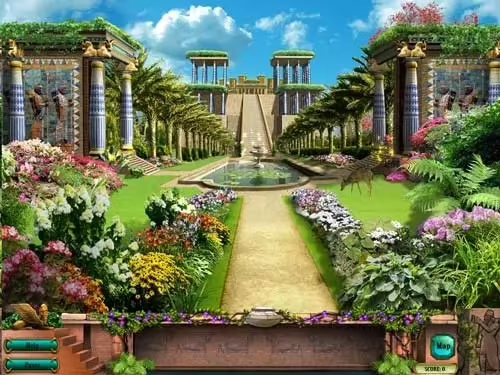
The Gardens of Babylon, as some imagine
Not only Philo mentioned the gardens, but historians rely on many other sources that come to mention them, including the geographer Strabo, and the Greek author Diodorus Siculus, who described the gardens as “wonders.”
After much confusion about Philo, Diodorus and other historians and writers and their accounts of Babylon and its antiquities, historians decided to search for another source of information, an older source, a writer such as Calisthenes, the court historian of Alexander and nephew of the philosopher Aristotle , and the writer Cléterchus, biographer of Alexander the Great. In addition to another important source, the Babylonian priest Berossus, the details that this priest wrote about the gardens seem to have inspired all the artists who came after him.
But documents are one thing, and on the ground is another, so where do we look? All the excavations and excavations that took place in Babylon did not produce a result. What about the arched structure that was found in the northern corner of the southern palace of Babylon in 1899! no! Not a trace of the gardens, it might have been a warehouse, or so the scholars agreed. What about the spaced holes found in the bricks from which the ziggurat of Ur was built! Is it evidence of the irrigation system they used to water the gardens! no! Holes are made to ensure even drying of the brickwork during its construction.
So, did the Hanging Gardens of Babylon disappear, or did they never exist? Faced with this lack of documentary and archaeological evidence, some scholars have asked the question, What if the Hanging Gardens were not built in Babylon in the first place, what if we were looking in the wrong place!
Greco-Roman sources referring to the Hanging Gardens tend to mention historical details intertwined with myths. For example, Diodorus places Nineveh, the capital of the Assyrians, on the bank of the Euphrates, while it is on the banks of the Tigris. In another passage, Diodorus explains a lion hunting scene depicted on the walls of Babylon, which was not found in Babylon, but which corresponds closely with the Assyrian hunting inscriptions inscribed on the stone walls of the northern palace in Nineveh!
Oxford University Assyriologist Stephanie Daly says that based on records of the reign of the Assyrian ruler Sennacherib ( 704-61 B.C.), they were found carved on prismatic stones. On one of these inscriptions, King Sennacherib boasts of the astonishing building he built: “The height of the circumference of the palace has been raised to be a marvel for all peoples...a high garden like the Amanus Mountains, next to which were placed all kinds of aromatic plants.”
Will the Hanging Gardens of Babylon become the Hanging Gardens of Nineveh?
Future research and excavations may or may not reveal this lost mystery.
https://www.arageek.com/2021/08/22/mysterious-civilization-from-middle-east?fbclid=IwAR2DEwS6s_qGk-pqYyOI6j3GkwhqiejdeAHf2m0GT08NgACxNvA2bR9pcbw

